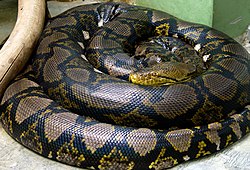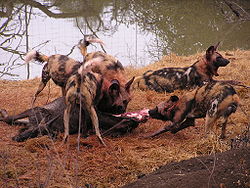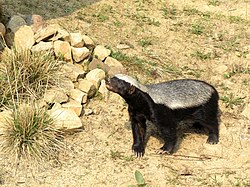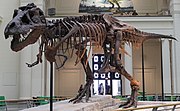Apex predator
An apex predator, also known as an alpha predator, super predator, top predator or top-level predator, is a predator residing at the top of a food chain on which no other creatures predate.[n 1][1][2] Apex predators are usually defined in terms of trophic dynamics, meaning that apex-predator species occupy the highest trophic level or levels and play a crucial role in maintaining the health of their ecosystems. One study of marine food webs defined apex predators as greater than trophic level four.[3] The apex predator concept is commonly applied in wildlife management, conservation and ecotourism.
Food chains are often far shorter on land, with their apices usually limited to the third trophic level – for example, giant constrictor snakes, crocodilians, hyenas, wolves or big cats preying mostly upon large herbivores. Apex predators do not need to be hypercarnivores: humans,[4] for example, are both apex predators and omnivores.[5]
Ecological role
[edit]Apex predators affect prey species' population dynamics. Where two competing species are in an ecologically unstable relationship, apex predators tend to create stability if they prey upon both. Inter-predator relationships are also affected by apex status. Non-native fish, for example, have been known to devastate formerly dominant predators. One lake manipulation study found that when the non-native smallmouth bass was removed, lake trout, the suppressed native apex predator, diversified its prey selection and increased its trophic level.[6]
Effects on wider ecosystem characteristics such as plant ecology have been debated, but there is evidence of a significant impact by apex predators. When introduced to subarctic islands, for example, Arctic foxes' predation of seabirds has been shown to turn grassland into tundra.[7] Such wide-ranging effects on lower levels of an ecosystem are termed trophic cascades. The removal of top-level predators, often – and, especially, recently – through human agency, can radically cause or disrupt trophic cascades.[8][9]
A now commonly-cited example of the effect of apex predators on an ecosystem is the dramatic changes in the Greater Yellowstone Ecosystem recorded after the gray wolf was reintroduced to Yellowstone National Park in 1995. Elk, the wolves' primary prey, became less abundant and changed their behavior, freeing riparian zones from constant grazing and allowing willows, aspens and cottonwoods to flourish, creating habitats for beaver, moose and scores of other species.[10] In addition to their effect on prey species, the wolves' presence also affected one of the park's vulnerable species, the grizzly bear: emerging from hibernation, having fasted for months, the bears chose to scavenge wolf kills,[11][12]Template:Refpage especially during the autumn as they prepared to hibernate once again.[12]Template:Refpage The grizzly bear gives birth during hibernation, so the increased food supply is expected to produce an increase in the numbers of cubs observed.[13] Dozens of other species, including eagles, ravens, magpies, coyotes and black bears have also been documented as scavenging from wolf kills within the park.[14]
Keystone species, a concept first described by zoologist Robert Paine to explain the relationship between the starfish species Pisaster ochraceus and mussel species Mytilus californianus, are apex predators within functional groups.[15]
Gallery
[edit]-
The saltwater crocodile is the largest living reptile[16] and is the dominant predator throughout its range.[17] The related Nile crocodile, which even preys upon Great Apes (humans and chimpanzees), is at the top of the food chain in African waters.
-
Wolves operate in packs in which each wolf has a specialized role in hunts that would otherwise fail, often against prey much larger than the individual wolves. All wolf subspecies, including dogs and dingos, and the closely related coyote, are menaces to wildlife, livestock, and vermin—and are competent defenders.
-
The tiger is one of the largest non-aquatic mammalian predators in the world. Pictured is the Bengal tiger, the largest subspecies of tiger and is most infamous for man-eating. All members of the cat family, including even the domestic cat with obvious similarities of build and behavior to tigers and leopards, are consummate predators irrespective of size.
-
A type B killer whale observes a Weddell seal on an ice floe near Rothera Station, along the Antarctic Peninsula. Killer whales are known to sometimes kill other whales while hunting in packs, earning them the title "Wolves of the Sea", and even kill great white sharks and leopard seals as prey.[18]
-
Electric eels have a defense that no non-human predator can circumvent. Caimans, jaguars, giant otters, piranhas, and humans usually avoid them lest they get a defensive electrical shock, the same sort of electrical shock that it uses for subduing prey.
-
Humans, with high intelligence and systematic use of tools such as hunting weapons (e.g., firearms, fishing rods and such animal accomplices as falcons and hunting dogs in contemporary history), are the world's most successful apex predators, and reside at the top of the food chain throughout the world.[19]
-
The reticulated python, one of the largest snakes, has only its long, powerful body as a weapon. But that body is enough to kill by suffocation of its victims, and any animal that can avoid it stays out of its reach.
-
The whale shark, the world's largest shark and fish, has a reputation as a "gentle giant" as a filter feeder. Despite having no prey larger than small fish, it has no natural predators and is an apex predator.
-
Birds of prey (like this Bald eagle) occupy the top of their food chains and are apex predators.
-
With this lethal mouth and a powerful swing of its tail, the American alligator has only armed humans and larger alligators to fear in the swamps of subtropical and tropical North America in which this predator lives.
-
Cape hunting dogs combine the usual traits of large predatory Carnivora (speed, strength, agility, power, intelligence, voracity, keen senses, and razor-sharp teeth) with a wolf-like pack instinct that allows them to rival lions and hyenas as hunters of the African savanna.
-
Convergent evolution has given the Tasmanian devil a superficial similarity to such small, formidable apex predators among the Carnivora as badgers and terrier dogs—but they are very different mammals of the marsupial order. They are similarly deadly to small animals as true Carnivorans of like size.
-
The honey badger is a fierce predator capable of holding its own against such predators as snakes, big cats, bears, hyenas, dogs, and humans. It gets its name from its ability to take honey and the bees that defend it. Its prey also includes cobras.
-
In this diorama, the giant squid loses to a larger and more intelligent predator, the sperm whale. Sperm whales often bear scars from encounters with giant squid that ended with the squid being eaten.
-
Driver ants, also known as siafu, are intrepid predators despite their blindness and the smallness of individual ants. This is due to the size of their swarms. Excruciating pain from their bites keeps larger animals from attacking them.
-
The Eurasian brown bear, whose range paradoxically extends into North America where it may be known as a grizzly bear or a Kodiak bear is a versatile, adaptable omnivore.
-
The Polar bear is the largest living species of terrestrial predator. The aforementioned Kodiak Bear is the only species to rival it in that regard. The largest polar bear on record, reportedly weighing 1,002 kg (2,209 lb), was a male shot at Kotzebue Sound in northwestern Alaska in 1960.
-
Tyrannosaurus rex was one of the supreme predators of its time.
Notes
[edit]- ^ Zoologists generally define predation as the non-parasitical or non-bacterial killing and consumption of organisms.[citation needed]
References
[edit]- ^ "predator". Online Etymological Dictionary. Retrieved 2010-01-25.
- ^ "apex predator". PBS. Retrieved 2010-01-25.
- ^ Essington, Timothy E.; Beaudreau, Anne H.; Wiedenmann, John (December 2005). "Fishing through marine food webs" (PDF). Proceedings of the National Academy of Sciences. 103 (9): 3171–3175. doi:10.1073/pnas.0510964103. PMC 1413903. PMID 16481614. Retrieved 2010-01-25.
- ^ Archer, Michael: "Slime Monsters Will Be Human Too" in Nature Australia vol. 22 (1989).
- ^ Haenel H (1989). "Phylogenesis and nutrition". Nahrung. 33 (9): 867–87. PMID 2697806.
- ^ Lepak, Jesse M.; Kraft, Clifford E., Weidel, Brian C. (March 2006). "Rapid food web recovery in response to removal of an introduced apex predator" (PDF). Canadian Journal of Fisheries and Aquatic Sciences 63 (3): 569–575. ISSN: 0706-652X. Retrieved 2010-01-25.
- ^ Croll, D. A.; Maron, J. L.; et al. (March 2005). "Introduced predators transform subarctic islands from grassland to tundra". Science. 307 (5717): 1959–1961. doi:10.1126/science.1108485. PMID 15790855. Retrieved 2010-01-25.
{{cite journal}}: Explicit use of et al. in:|author3=(help) - ^ Egan, Logan Zane; Téllez, Jesús Javier (June 2005). "Effects of preferential primary consumer fishing on lower trophic level herbivores in the Line Islands" (PDF). Stanford at Sea. Stanford University. Retrieved 2010-01-25.
- ^ Pace, M. L.; Cole, J. J.; et al. (December 1999). "Trophic cascades revealed in diverse ecosystems". Trends in Ecology and Evolution. 14 (12): 483–488. doi:10.1016/S0169-5347(99)01723-1. PMID 10542455.
{{cite journal}}:|access-date=requires|url=(help); Explicit use of et al. in:|author3=(help) - ^ Bystroff, Chris, "The wolves of Yellowstone" (2006-04-17), p. 2. Retrieved 2010-01-25.
- ^ Levy, Sharon (November 2002). "Top Dogs". Retrieved 2010-01-25.
- ^ Jump up to: a b Wilmers, Christopher C. (2004). "The gray wolf – scavenger complex in Yellowstone National Park" (PDF). Retrieved 2010-01-25.
- ^ Lua error in package.lua at line 80: module 'Module:Citation/CS1/Suggestions' not found.
- ^ Wilmers, Christopher C.; Getz, Wayne M. (April 2005). "Gray wolves as climate change buffers in Yellowstone". PLoS Biology 3 (4): e92. doi: 10.1371/journal.pbio.0030092. Retrieved 2010-01-25.
- ^ Davic, Robert D (2003). "Linking keystone species and functional groups: a new operational definition of the keystone species concept". Conservation Ecology 7 (1): r11. Retrieved 2010-01-25.
- ^ "Saltwater Crocodile." National Geographic. Retrieved 2010-01-25.
- ^ Whiting, Frances. "Terri fights to halt croc eggs harvest." Australia Zoo. 2007-06-11. Retrieved 2010-01-25.
- ^ "Orcinus orca – Orca (Killer Whale)". Marinebio.org. Retrieved 2012-03-04.
- ^ "Evolution and General Intelligence: Three hypotheses on the evolution of general intelligence". Scientific American. 1998. Retrieved 30 October 2013.
- All articles with unsourced statements
- Articles with unsourced statements from February 2015
- Articles with invalid date parameter in template
- Pages using the JsonConfig extension
- Pages with script errors
- CS1 errors: explicit use of et al.
- CS1 errors: access-date without URL
- Articles with hatnote templates targeting a nonexistent page
- Predation

![The saltwater crocodile is the largest living reptile[16] and is the dominant predator throughout its range.[17] The related Nile crocodile, which even preys upon Great Apes (humans and chimpanzees), is at the top of the food chain in African waters.](https://upload.wikimedia.org/wikipedia/commons/thumb/4/43/SaltwaterCrocodile%28%27Maximo%27%29.jpg/250px-SaltwaterCrocodile%28%27Maximo%27%29.jpg)
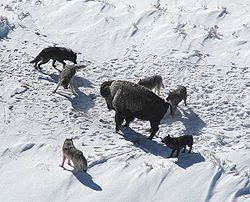

![A type B killer whale observes a Weddell seal on an ice floe near Rothera Station, along the Antarctic Peninsula. Killer whales are known to sometimes kill other whales while hunting in packs, earning them the title "Wolves of the Sea", and even kill great white sharks and leopard seals as prey.[18]](https://upload.wikimedia.org/wikipedia/commons/thumb/d/d3/Killer_Whale_Tipe_B.jpg/250px-Killer_Whale_Tipe_B.jpg)

![Humans, with high intelligence and systematic use of tools such as hunting weapons (e.g., firearms, fishing rods and such animal accomplices as falcons and hunting dogs in contemporary history), are the world's most successful apex predators, and reside at the top of the food chain throughout the world.[19]](https://upload.wikimedia.org/wikipedia/commons/thumb/6/6e/Quail_Hunting_with_Dogs.jpg/250px-Quail_Hunting_with_Dogs.jpg)
